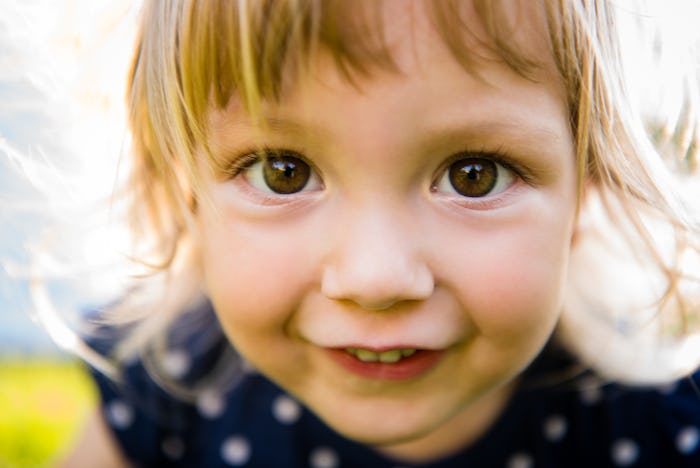With my child, I never wished she would get to certain milestones before they happened. That's mostly because I had very little idea what was actually coming next, but I also had what felt like all the time in the world to soak up every stage. But the second kid? I often look at my 8-month-old and wish he could give me some indication of what the heck he wants. It sure would be faster! While a young toddler may not be ready to verbalize his needs, there are ways to help toddlers communicate before they can talk, and you can bet my second kiddo is going to get the full dose of all three.
Sign language is the most common and widest known way to help your toddler communicate before they can talk, but there are also ways to use your body language and facial expressions to teach your child to express themselves more clearly before they can actually form words.
Sign language has been known to have immediate and long lasting benefits for babies and kids. Psych Central explained, "It helps reduce the guesswork of understanding your infant’s thoughts, as well as allowing two-way conversations. Parents may develop a better understanding of the child’s personality. It also could save much time and frustration." Save time and frustration? Sign me up.
And those are the key ideas behind all three kinds of preverbal communications: helping your toddler communicate their feelings or needs before they can actually speak can help you know how to help them and avoid some of the famous toddler meltdowns that are caused by their inability to get their message across.
If you have a toddler who isn't ready to talk yet but seems to have some things to "say", start here.
1Mirroring With Body Language
Body language is extremely important when you're trying to communicate with a kid who can't speak yet. "Positive nonverbal communication can improve your relationship with your child and boost emotional connections in your family," according to the Australian parenting website Raising Children. One way to use body language to help encourage your child to communicate is to mirror what they're doing, which "means using the same facial expression or tone of voice as your child. It can show him that you’re trying to understand his feelings. For example, if your child smiles at you, smile back. If he’s sad, nod your head and look a bit sad yourself."
2Sign Language
Sign language is something you can start teaching a baby as young as six months, and within a few months he or she should be able to start repeating signs back to you, effectively communicating their needs. Psych Central explained that when your baby can hold your gaze for a few seconds at a time, they're ready for you to start demonstrating signs. "Start with three to five signs, using eye contact and saying the word out loud. Try signs which are easily linked to objects, such as “ball," they said.
Speech therapist Cara Barthelette said in her baby sign language video with Bundoo, that signs for milk, all done, more, yes, and no, are all popular with the preverbal set because they indicate requests. Once you master these beginning signs with your baby, you can start bringing in more signs depending on your needs or your kid's interests.
The parenting website Fine Parenting also explained that gestures we make every day can help teach our toddlers to communicate before they can speak: "Head nods, thumbs up, and hands up in excitement also positively impact interactions with children. We are nonverbally expressing acknowledgement and encouragement to our children."
3Facial Expressions
With a little careful watching, you might find that your toddler is already trying to communicate with you via facial expressions. In an article on nonverbal communication with children, the Guyana Ministry of Education explained that children's emotions actually shine through their faces without any filter. "Children are very easy to figure out when they like or dislike something. Facial expressions typically give away what a child is thinking or feeling."
They suggested asking specific questions of your child and using their corresponding facial expressions to learn how to read your child. "Catching facial expressions and asking the right questions will provide you with a way to understand more deeply what she is thinking or feeling," they advised.
Using this type of communication with your child can teach her that using her own facial expressions can help you understand what she is feeling or needing.
Check out Romper's new video series, Bearing The Motherload, where disagreeing parents from different sides of an issue sit down with a mediator and talk about how to support (and not judge) each other’s parenting perspectives. New episodes air Mondays on Facebook.
